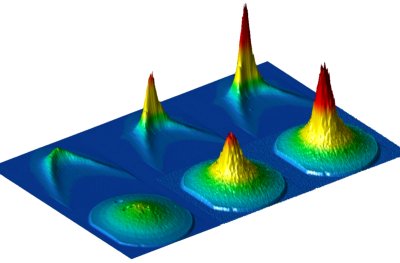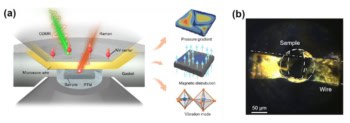Two separate research groups claim to have witnessed a widespread collapse to the ground state in different quasiparticle systems, raising questions over what can really constitute a Bose--Einstein condensate.

On the surface, the definition of a Bose–Einstein condensate (BEC) appears resolutely clear: when a mass of bosons is cooled below a critical temperature, there is a phase transition wherein a significant portion of the bosons collapse into the first quantum state. Therefore it might come as a little surprise to find doubt surrounding the latest two papers to demonstrate it.
The first of two papers on BECs published in Nature this week describes experiments performed in France and Switzerland that created half-light, half-matter quasiparticles in a semiconductor using a focused laser (Nature 443 409). These so-called “polaritons” are bosons each made up of an electron-hole pair (itself called an “exciton”) and a coupled photon. By increasing the density of polaritons, the team were eventually able to observe the macroscopic polarization and spatial coherence that are the tell-tale quantum signs of a BEC.
The experimental work was done by Jacek Kasprzak and colleagues at the Université J. Fourier-Grenoble and Benoit Deveaud-Plédran and co-workers at Ecole Polytechnique Fédérale de Lausanne (EPFL).
“We were able to show in previous studies that a large number of polaritons could be accommodated in the same state, while still keeping their bosonic character,” recalls Deveaud-Plédran. “This was not at all obvious in the beginning. When you raise the density of composite bosons, they have a tendency to dissociate into the constituent particles.”
This study is a breakthrough because the BEC could be witnessed at the cryogenically-obtainable temperature of 19 K, made possible by the extremely small mass of polaritons. They are a billion times lighter than rubidium atoms, which were the first atoms to be cooled to a BEC in 1995. Moreover, the authors claim this is the first true example of a BEC in the solid state.
Unfortunately, two inescapable practicalities of using these quasiparticles will have left some overly-shrewd physicists fidgeting in their seats over the absolute definition of a BEC. First, they would say, the system was confined to two-dimensions, which means that fluctuations would push regions out of phase with each other. Second, the polaritons live for only the order of a picosecond, which reduces the likelihood of thermal equilibrium being reached.
But Deveaud-Plédran happily dismisses both assertions. “BEC is forbidden only in two dimensions for an infinite system without disorder. We have a finite system with disorder, so standard BEC is allowed. And despite the quasiparticle nature and very short lifetime, we have shown that we are able to get a thermal equilibrium.”
Room temperature BEC
In the other paper, a group led by the Institute for Applied Physics at the University of Münster in Germany has sparked interest by declaring the first room-temperature BEC (Nature 443 430).
“Usually, it is very difficult to create an equilibrium density of particles at high transition temperatures,” explains Sergej Demokritov of Münster. “So until now the main approach has been to decrease the temperature below the transition temperature. Instead, we increase the density of particles for several microseconds to increase the transition temperature dramatically.”
In this instance, the quasiparticles are “magnons” – the term used for packets of magnetic energy, in the same way “photons” are deemed packets of light energy. Demokritov and his team pumped magnons into solid films of the compound yttrium-iron-garnet using microwaves. When the pumping reached a critical rate, they could watch out for the formation of a BEC by monitoring the chemical potential of the magnons.
According to Demokritov, “unambiguous” proof of a BEC was found when the chemical potential reached that of the lowest magnon state. “If the lifetime of the particles is much longer than the time they need to scatter with each other, [thermal equilibrium] condensation is still possible. In our case, the ratio between the lifetime and the scattering time is at least above 30.”
The argument seems to fold into a question of relative timescales. If the quasiparticles interact with each other much more quickly than they decay, it is justifiable to predict the formation of a BEC. And both groups’ experiments easily satisfy this criterion. “It’s a bit like going from valves to transistors,” says Deveaud-Plédran. “The effect is the same, but the size, the temperature and the practicability differ a lot.”


